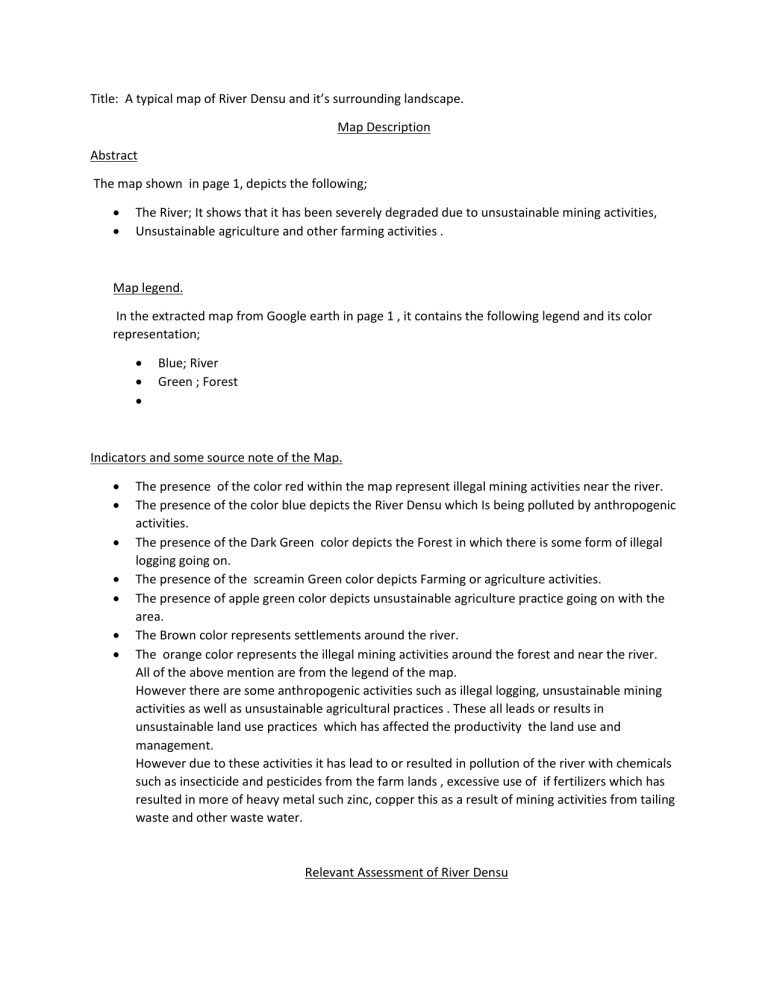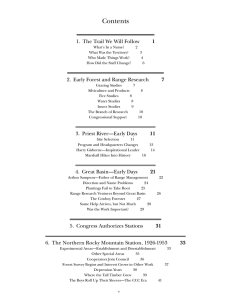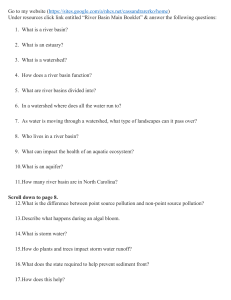
Title: A typical map of River Densu and it’s surrounding landscape. Map Description Abstract The map shown in page 1, depicts the following; The River; It shows that it has been severely degraded due to unsustainable mining activities, Unsustainable agriculture and other farming activities . Map legend. In the extracted map from Google earth in page 1 , it contains the following legend and its color representation; Blue; River Green ; Forest Indicators and some source note of the Map. The presence of the color red within the map represent illegal mining activities near the river. The presence of the color blue depicts the River Densu which Is being polluted by anthropogenic activities. The presence of the Dark Green color depicts the Forest in which there is some form of illegal logging going on. The presence of the screamin Green color depicts Farming or agriculture activities. The presence of apple green color depicts unsustainable agriculture practice going on with the area. The Brown color represents settlements around the river. The orange color represents the illegal mining activities around the forest and near the river. All of the above mention are from the legend of the map. However there are some anthropogenic activities such as illegal logging, unsustainable mining activities as well as unsustainable agricultural practices . These all leads or results in unsustainable land use practices which has affected the productivity the land use and management. However due to these activities it has lead to or resulted in pollution of the river with chemicals such as insecticide and pesticides from the farm lands , excessive use of if fertilizers which has resulted in more of heavy metal such zinc, copper this as a result of mining activities from tailing waste and other waste water. Relevant Assessment of River Densu Water is abundant on the plant as a whole but fresh portable water is not always available at the right time for human or ecosystem use. Also the forest is also of important in terms of environmental, ecological economic and social benefits, however the forest is also not in good shape due to unsustainable anthropogenic activities such as illegal logging. Due to increase in population in the Densu basin or land scape in Ghana, there is the need for proper conservation and efficient utilization of freshwater bodies as well as the forest for sustainable development. The population pressures in the basin can severely degraded water quality because of increased domestic, municipal, agricultural and industrial activities as well as destroy the forest all this in order to gain profit or food at the expense of the river and the forest . Assessment of the River Densu and it surrounding landscape in terms of physical , economic, social and Environmental condition. The Densu River Basin has an area of 2,490 km2 and spans 11 Local Government Assemblies in three regions (i.e. Central Region, Eastern Region and the Greater Accra Region). There are about 200 settlements in the Basin and the total population is over 600,000, equivalent to 240 persons per km2. This figure is visibly far higher than the national average of about 100 persons per km2. The main occupation is agriculture, which engages about 40% of the economically active population. The vegetation consists of coastal savannah, thicket and grassland in the south, and moist semideciduous forest in the north. The river takes its source from the Atewa Range near Kibi and flows for 116 km into the Weija Reservoir before entering the Gulf of Guinea through the Densu Delta Ramsar Site. Environmental Condition on the River as well the micro-catchments around The major environmental concerns are erosion, siltation and pollution of the river, garbage and human wastes and excreta disposal and waste from industries. Agricultural activities in the basin have caused considerable damage to the environment and polluted the river. Human contact and use of the water for bathing, washing,swimming, irrigation and gardening are intense in the basin. These situations have resulted in pollution and signs of water-associated diseases (e.g. bilharzia, enteric infectionsand intestinal worms) in the area. Industrial wastes from fruit processing factories, and other industries are discharged into the river. However environmentally, the river would not be able to support other organisms within the river and other organisms such as birds that indirectly depend on the river for survival as well as humans. However there’s Indiscriminate harvesting of wood from the micro-catchments of the river, these plants and trees around helps by regulating noise in a form of moving waves which are intercepted by the forest cover, it also helps in the filter of air. Therefore in this situation ( Indiscriminate cutting of wood around the catchment of the river) has drastically reduced all this functions and services. Physical Condition on the River as well the micro-catchments around. Physically the River Densu and it’s micro catchment area are degraded through the following actions; Agriculture (food crops and rearing of animals) on the banks of the river. The use of agrochemicals in farming and harmful chemicals in fishing all this enhance the damaging of the River. Infrastructure development including the siting of industries at unauthorized locations Inappropriate disposal of solid waste and liquid waste from the Local Government Assemblies, farms, domestic and industrial sources into the river Mining including sand winning and quarrying in and around the Basin. In the above mention the following activities have contributed greatly to the degrading or destroying the water body( river Densu) by changing , the following elements within the river; Coloration of the river turns to either dark red, dark brown due to excessive use of fertilizer , pesticides and insecticide as well as the illegal mining going on around the basin. Elements such oxygen will be depleted and organism within and around are going into extinct. The is reduction in the water table, which will affect the people in terms of water availability for the plants and trees around as well as water for human consumption and domestic use. Socio-Economic Condition on the River as well the micro-catchments around. The socio economic effects can be as a result of physical effects or anthropogenic activities such as illegal logging of woods in the catchment area of the basin, unsustainable agriculture and mining activities. These will result in following; There will be increase in the scarcity of forest products such timber and non timber forest products (NTFP) Increase in poverty which in tend will result to migration. A productive land use for the landscape and it surrounding. Sustainable agriculture practice Sustainable mining activities A land use plan for the productive land use Objectives Reducing heavy metals within the river body. Determine the quantity of heavy metals Determine the availability of groundwater. Determine water quantity and quality. Description Problems; Illegal mining, unsustainable logging activities and unsustainable agriculture practice. Abstract. Activities in and around River Densu Basin poses a threat to the quality of the river. This study, therefore, assesses the impact of human activities on the water quality of River Densu . Some alternatives for environmental, economic and social analysis. The use of Water Quality Index (WQI) and Nemerow’s Pollution Index. These were used in measuring the water quality to establish the extent of deterioration resulting from human activities. The data for the assessment was secondary data (2010-2015) obtained from the Ghana Water Company Regional laboratory in Weija Accra Ghana. Generally, catchment activities such as illegal mining, farming along the banks of the river, and discharge of untreated waste are the main processes polluting the Densu river which is a serious threat to the health of inhabitants in villages which still use the water for cooking activities. Another contributor to the reduced forest cover is the logging of timber for export and industrial activities as well as harvesting of fuelwood for domestic activities. This has strong consequences on evaporation, infiltration, and surface runoff during rainfall. The Densu River is under serious threat of eutrophication, algal toxicity with related health hazards, resulting from indiscriminate disposal of waste, flooding, improper use of agro-chemicals, illegal fishing methods, leaching from waste dumps, effluent discharge and accidental spills from industries The river is further threatened by bauxite mining from where the river takes its sources as well as unregulated or illegal mining of gold in and around the river. In addition, available information from indicates that the basin environment has experienced rapid change from rural to urban leading to an increase in population and volumes of potable water usage. Analytical tools used. Water Quality Index (WQI) A water quality index is a classification tool used to determine the state of a water source for a certain period. Nemerows Pollution Index (NPI) Nemerow’s pollution index measures the pollution potential of individual pollutants in a sampled area with reference to its standard value. Conclusion This study shows that the water quality of River Densu is continuously deteriorating and being polluted with turbidity, ammonia (NH3), iron (Fe), phosphorus (P), and aluminium (Al) which is an indication of how human activities are influencing the quality of water in the basin. The deterioration and pollution are heavily influenced by the illegal mining carried out upstream of the river. Other factors contributing to the pollution and deterioration include agricultural runoffs and domestic activities in the River Basin. Recommendation We therefore proposes that illegal mining activities, discharge of untreated wastewater and agricultural activities such as farming along the banks of the river should be monitored and regulated and if possible halted. Relevant environmental laws should also be enforced to apprehend illegal miners and streamline the activities which go on in the basin. However sustainable agriculture should also be practiced. That is, any agriculture farm should be at least 25 meters from the river so as to prevent pollution from chemicals in the fertilizer. References https://www.scirp.org/journal/paperinformation.aspx?paperid=97054#f1. Water resources commission of Ghana. https://doi.org/10.1016/j.ejrh.2022.101017. The Forest service Division.


